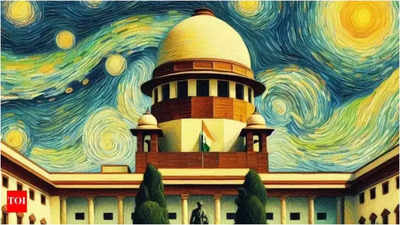
NEW DELHI: At a time when language has become politicised, with incidents of people being attacked in several states for not speaking the local language, Supreme Court has said India's linguistic diversity should be celebrated and it should not cause divisions. It said language was not related to any religion and Urdu was as much an Indian language as Hindi and Marathi, reports Amit Anand Choudhary. SC upheld use of Urdu, along with Marathi, on a signboard of Patur municipal council in Maharashtra's Akola district.
T he court said there was a misconception that Urdu was alien to India and observed that it was “pitiable” to consider Hindi as the language of Hindus and Urdu of Muslims, a ploy used by the colonial powers to divide the country. “The prejudice against Urdu stems from the misconception that Urdu is alien to India. This opinion, we are afraid, is incorrect as Urdu, like Marathi and Hindi, is an IndoAryan language. It is a language which was born in this land. Urdu developed and flourished in India due to the need for people belonging to different cultural milieus who wanted to exchange ideas and communicate amongst themselves. Over the centuries, it attained ever greater refinement and became the language of choice for many acclaimed poets,” a bench of Justices Sudhanshu Dhulia and K Vinod Chandra said.
“Language is not religion. Language does not even represent religion. Language belongs to a community, to a region, to people; and not to a religion. Language is culture. Language is the yardstick to measure the civilisational march of a community and its people. So is the case of Urdu, which is the finest specimen of Ganga-Jamuni tehzeeb, or the Hindustani tehzeeb, which is the composite cultural ethos of the plains of northern and central India,” the bench said.
Noting that a petitioner fought a legal battle against Urdu for the last five years before Bombay HC and SC, the court said the petitioner’s misconception over the issue of language should be addressed as many other people may also have the same feeling. The court said language was a medium for exchange of ideas that brought people holding diverse views and beliefs closer and it should not become a cause of their division.
The bench said even today, the Hindi used by common people was replete with Urdu words, even if one was not aware of it. “It would not be incorrect to say that one cannot have a day-today conversation in Hindi without using words of Urdu or words derived from Urdu. The word ‘Hindi’ itself comes from the Persian word ‘Hindavi’. This exchange of vocabulary flows both ways because Urdu also has many words borrowed from other Indian languages, including Sanskrit,” it said. The court said Urdu and Hindi were not two languages as per linguists and literary scholars and if Urdu was criticised, it was also a criticism of Hindi in a way. It expressed concern over deterioration of Hindustani language which is a mix of various languages including
Hindi and Urdu
.
“This is not an occasion to have an elaborate discussion on the rise and fall of Urdu, but this much can be stated that this fusion of Hindi and Urdu met a roadblock in the form of puritans on both sides and Hindi became more Sanskritised and Urdu more Persian. A schism exploited by the colonial powers in dividing the two languages on religion. Hindi was now understood to be the language of Hindus and Urdu of Muslims, which is such a pitiable digression from reality; from unity in diversity; and the concept of universal brotherhood,” the bench said. “We must respect and rejoice in our diversity, including our many languages. India has more than 100 major languages,” it added. The court said if people or a group of people residing within the area covered by the Patur municipal council were familiar with Urdu, then there should not be any objection if Urdu was used in addition to the official language, ie, Marathi, at least on the signboard of the municipal council.
.png)
 German (DE)
German (DE)  English (US)
English (US)  Spanish (ES)
Spanish (ES)  French (FR)
French (FR)  Hindi (IN)
Hindi (IN)  Italian (IT)
Italian (IT)  Russian (RU)
Russian (RU)  2 days ago
3
2 days ago
3









Comments